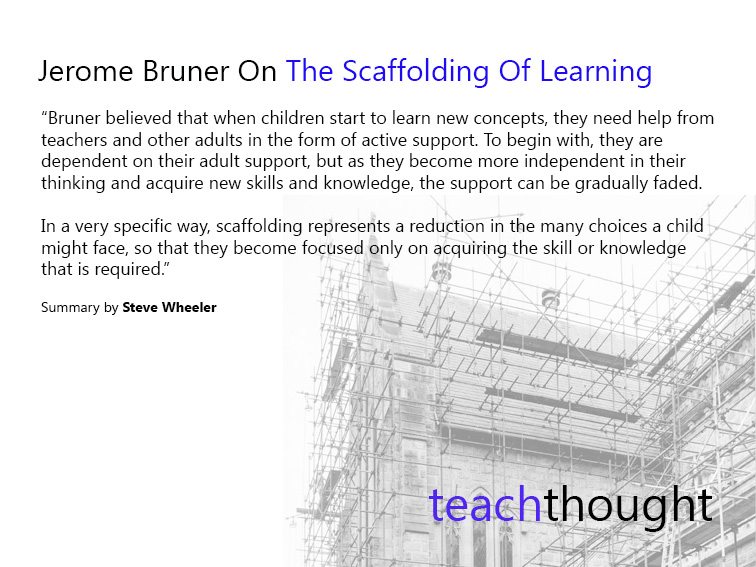Learning Theories: Jerome Bruner On The Scaffolding Of Learning
Bruner believed that when children start to learn new concepts, they need help from teachers and other adults in the form of active support.
Learning Theories: Jerome Bruner On The Scaffolding Of Learning
by Steve Wheeler, Associate Professor, Plymouth Institute of Education
In this post, we explore the work of Jerome Bruner on scaffolding of learning. This is a simplified interpretation of the theory, so if you wish to learn more, please read the original works.
The Theory
Bruner’s theory of scaffolding emerged around 1976 as a part of social constructivist theory, and was particularly influenced by the work of Russian psychologist Lev Vygotsky. Vygotsky argued that we learn best in a social environment, where we construct meaning through interaction with others. His Zone of Proximal Development theory, where we can learn more in the presence of a knowledgeable other person, became the template for Bruner’s model.
Bruner believed that when children start to learn new concepts, they need help from teachers and other adults in the form of active support. To begin with, they are dependent on their adult support, but as they become more independent in their thinking and acquire new skills and knowledge, the support can be gradually faded. This form of structured interaction between the child and the adult is reminiscent of the scaffolding that supports the construction of a building. It is gradually dismantled as the work is completed.
In a very specific way, scaffolding represents a reduction in the many choices a child might face, so that they become focused only on acquiring the skill or knowledge that is required. The simplistic elegance of Bruner’s theory means that scaffolding can be applied across all sectors, for all ages and for all topics of learning.
How It Can Be Applied To Education
It is important for teachers to provide opportunities for children to constantly learn new things. Some of those may be highly complex and will require support of a very focused kind. Teachers need to be aware of the developmental state of each of the children in their care, and should provide scaffolding that is appropriate.
Although this may not be possible to do on their own, teachers can improvise and provide scaffolding through other support, including the use of other adults such as teaching assistants (para-educators) parent helpers, or more knowledgeable other children within the classroom.
As children gain in confidence and competence in a particular areas, teachers might place them in groups to extend each other’s learning further. It’s also important that teachers recognise when a child is at the point where they begin to learn independently, and decisions can be made to set them free from the scaffolding.
Reference
Wood, D. J., Bruner, J. S. and Ross, G. (1976). The role of tutoring in problem solving. Journal of Child Psychiatry and Psychology, 17(2), 89-100.
Learning Theories: Jerome Bruner On The Scaffolding Of Learning by Steve Wheeler is licensed under a Creative Commons Attribution-NonCommercial-ShareAlike 3.0 Unported License.
This post first appeared on Steve’s personal blog; image attribution wikimedia.commons

